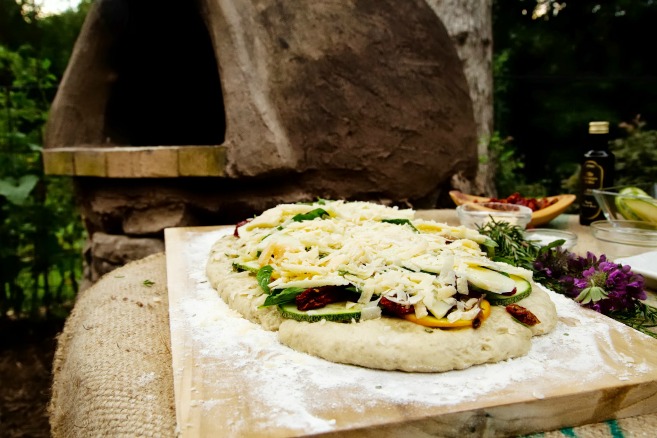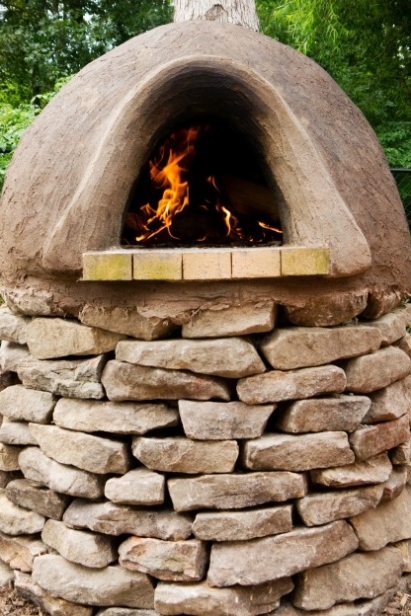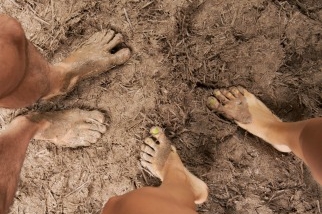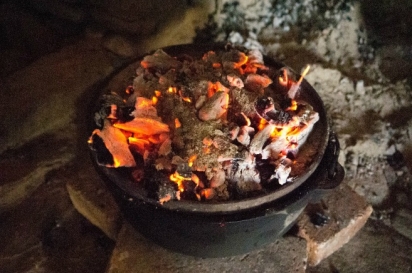Baking With Earth: The Search for the Perfect Wood-Fired Oven
Newly-risen loaves of bread dough, stuffed heirloom pumpkins, blueberry cobbler, uncooked pizzas and a giant pot of venison stew wait on an outdoor table, ready to enter the scorching interior of the wood-fired oven. The baker removes a rounded, water-soaked wooden cooking door, and throws in a pinch of flour to check the oven’s temperature. The flour quickly blackens, sending up a small puff of smoke.
“Still too hot, probably about 800 degrees,” she says. This is no first-hand account from a rustic French restaurant overlooking the Mediterranean. It’s our backyard in Greenville, South Carolina, an edible oasis where we grow hundreds of varieties of unusual and heirloom produce year-round. Thanks to a strange mélange of friends, internet contacts and earth oven experts, we’ve managed to hand-build—or perhaps more accurately foot-build—the perfect wood-fired oven.
If you’ve ever eaten a slice of wood-fired pizza or bread, you’re probably already aware of the unique texture and flavor this method of cooking imparts to food. An electric oven simply can’t compare. Ours is no ordinary wood-fired oven, either. It’s a “cob” oven constructed from natural materials abundant in the Upstate: clay, stone, sand and straw. It’s designed for maximum heating efficiency, using both ancient construction techniques and modern thermodynamics.
To bake with a cob oven, you start by building and maintaining a wood fire for at least two hours. A slow, hot-burning hardwood like oak is ideal. Next, you remove the embers and the oven starts to slowly cool from around 1000° to about 700°. That’s when the cooking actually begins. The first items to go in the oven are high heat-loving foods such as pizza, which cook to crusty, wood-fired perfection in as little as two minutes. Stews, pies, roasts and other slower cooked items go in next. After a few more hours, the oven’s interior cools to under 400°, at which point smaller items like muffins and cookies take their turn.
The extremely high interior temperatures and near-magical cooking properties of a cob oven come from all three forms of heat transfer: radiation from the walls and roof, conduction from the surface of the fire bricks and convection from the steamy, swirling interior air. Electric ovens, at best, only use radiation and convection. Unlike wood-fired ovens, electric coils impart no additional flavors or nuance to the foods cooked inside of them.
Combined, the technical attributes of a well-made cob oven translate into breads, pizzas and other baked goods that cook quickly and evenly, feature deliciously crunchy crusts (sugar molecules on the surface of wheat crusts caramelize under the extreme steamy heat) and a distinctively earthy flavor you just don’t find anywhere else.
Beyond science, many aficionados simply say that wood-fired ovens give food a soul. We agree. We’ve never been able to fathom how any benevolent, omnipotent deity could possibly reward store-bought white bread or frozen pizza with immortality. But our homemade wood-fired pizza topped with sun-dried tomatoes, arugula and heirloom hardneck garlic (all from our garden) certainly has a soul deserving of eternal life.
Wood-fired ovens and foods are experiencing a revival in all types of kitchens. Celebrity chefs at many of the country’s top upscale restaurants are designing (or redesigning) their restaurants around wood-fired ovens. (Sean Brock’s Husk restaurants in Charleston and Nashville both feature wood-fired ovens and fare.)
The history of cooking with wood is as long as the history of cooking, and we were excited to come across Carol Bozarth’s Pioneer Hearth cooking class at Hagood Mill in Pickens. This class is probably as close as we’ll ever come to a time machine. It’s one thing to read about how American pioneer families used to live and cook, it’s another thing to actually experience it for half of a day.
When we arrived at the mill, we saw a stream of smoke coming out of a chimney at one of the small, rustic on-site cabins. Inside, Carol and her friend Talley Parker were already well underway with preparations.
Carol and Talley take their roles as custodians of early European-American history quite seriously. They dress in period clothing and use only tools, utensils and resources that would have been available to a pioneer living in the late 1800s. There’s no electricity or running water in the cabin. Most of the ingredients are seasonal and either grown, foraged or milled on-site (Hagood Mill is one of the few functioning water-powered gristmills in the country).
Interestingly, the hearth cooking methods and technologies Carol and Talley share were still common in Upstate households until the mid-1900s, since many homes in our area did not have electric power. Carol still gets many visitors who tear up with childhood nostalgia when they see her cook.
Our lunch started with a dandelion and chickweed salad, two common varieties of nutrient-rich greens beloved by our pioneer ancestors and Native Americans alike. (In modern times, people call these “weeds,” spray them with toxic chemicals when they dare appear in their yard, then drive to a nearby grocery store to buy chemical-covered salad greens shipped from California, which hardly seems like progress.)
Our main course featured savory chicken and dumplings with wild onions. Carol had used a cast iron crane and “s-hook” attached to the fireplace to expertly swivel the pot of dumplings to various positions above the flames and embers. According to Carol, the invention of these two devices had allowed people to cook over fire on high, medium or low heat for the first time. Served with the dumplings was our first—and likely best—spoonbread, a soft, gooey corn-based dish whose closest living relative is a soufflé.
Dessert was a mixed berry cobbler that came out of the red-hot embers with the absolute perfect consistency. Carol had made the cobbler in the “Paul Revere” Dutch oven. Apparently, when he wasn’t fomenting political revolution, Mr. Revere was revolutionizing hearth cooking. The indented, lipped lid he invented allowed the Dutch oven’s contents to be heated from above and below, since coals could now be placed on top of the pot.
To finish off the meal, Carol hand-roasted organic green coffee beans using a traditional fire-roasting implement, hand-ground the beans using an antique contraption, boiled the grounds in a pot, then served us a cup of coffee.
“This kind of cooking is a folk art,” Carol said as we all washed our dishes out back of the cabin using a pail of water hauled from the hand-pumped well by the mill.
While a pioneer-style hearth is a long way from a wood-fired oven, we left Carol’s class with a strong desire to carry the essence of that tradition forward. We knew we wanted an oven that matched the personality of our garden and one that we could make ourselves, by hand, using natural materials. The oven would also need to use wood more efficiently than a hearth, while still helping to make our home an unforgettable dining spot for family, friends and neighbors. As we realized from our time with Carol, all good food has an extraordinary story to share, and we feel a duty to be worthy biographers.
To find the answers to our questions, Susan turned to the modern equivalent of the Oracle at Delphi: Pinterest.
After entering a few keywords, the omniscient digital fairies that hand-crank Pinterest’s image servers produced the visual answer to our question: beautifully sculpted earthen ovens were being hand- made by people all over the world. They called them cob ovens.
“Cob” is the English term for mud building. Cob was the primary method of home construction throughout England fromthe 13th Century until around 1800, when bricks became more economical. Among its many attributes, cob provides excellent insulating properties and durability. In fact, many cob homes in England are still occupied and in perfect working order many hundreds of years after they were originally constructed.
The English didn’t invent cob. Earthen building construction using mud, straw and other natural materials was used as far back as 8,000 BCE, in what is now modern-day Jericho. Over the millennia, cob construction has also been utilized by virtually every culture around the world for every construction need imaginable: Pueblo adobe “apartment” buildings in the southwest US, Hmong houses in Vietnam, the watchtowers of the Han Dynasty in China, and countless other examples past and present.
Since we had no idea how to actually build a cob oven, we started by reading the book that is generally regarded as “required reading” for anyone looking to work with cob: Build Your Own Earth Oven by Kiko Denzer and Hannah Field. For several weeks before and during our cob oven construction, the majority of our conversations began and ended with sentences prefaced with “Kiko said...” We even considered making WWKS (What Would Kiko Say) bracelets, but decided to save that project for another day.
The most fascinating aspect of building a cob oven is how similar the process is to baking bread. You gather your ingredients, knead them together using precise ratios, then hand over your earthen “dough” structure to the fire which bakes it into a finished oven.
With a bit of patience, someone could easily gather the “ingredients” needed to build a cob oven for little or no money. It just so happens that our Appalachian red clay and sand subsoil—while terrible for growing food—is an ideal medium for making cob and baking food. Jacob Forrest, a friend and fellow permaculture enthusiast who consulted us on our cob oven, successfully built two separate cob ovens using our native red clay.
However, the absolute best clay for making cob is pure potters’ clay. While potters’ clay is not typically something you can find for free, we just happen to be friends with TimTv, a local artist and performer, who donated a huge pile of discarded potters’ clay in his yard to our project. Potters and potting studios make a handy resource for anyone interested in building a cob oven.
As for sourcing the other ingredients needed for a cob oven: with ample time and a pickup truck, it would be fairly easy to gather all the rocks or “urbanite” (old broken concrete), sand, straw and pebbles needed to build a cob oven’s foundation. Since we had neither time nor a truck, we decided to have our supplies dropped right in our driveway by our local Landscapers Supply.
Once we built our foundation, three friends came over for a fun morning of cob-stomping. This is the point in the construction process where things start getting fun.
Be warned: when stomping cob, you’re forced to perform a dance that’s a cross between really bad tango and “child who is about to wet his or her pants,” according to Kiko. If your neighbors happen to walk onto their porch and see you, a circle of friends and your Welsh Harlequin ducks doing your “cob dance” while covered in mud, it can be a bit awkward.
Offerings of fresh produce or wood-fired pizzas can go a long way towards placating any sense of neighborly discomfort. We’re not speaking from personal experience, of course.
A cob oven is never truly finished. Over time and with repeated use, the outer plaster layer will crack, due to both weather and the expansion and contraction that naturally occurs when a material reaches upwards of 1000° in just a few hours. Beyond the occasional requisite plaster patch, many people even redesign the tops of their cob ovens into ornate sculptures of animals or elegant geometric shapes.
When we cook with our cob oven, we’re not only connecting with many of the folk art cooking traditions from ages past, we’re forging new traditions that help enrich our current sense of time and place. Building our cob oven was not a fast or easy process, but as soon as we tasted our first homemade wood-fired focaccia bread topped with seasonal vegetables from our garden, we knew that it was worth every minute of hard labor and mud-dancing we’d invested into the process.








